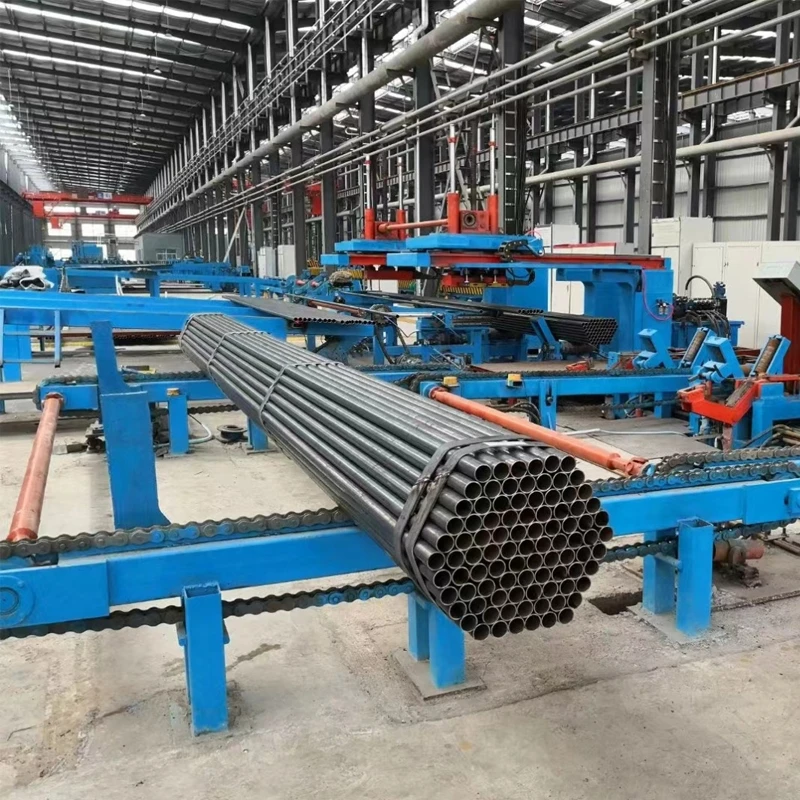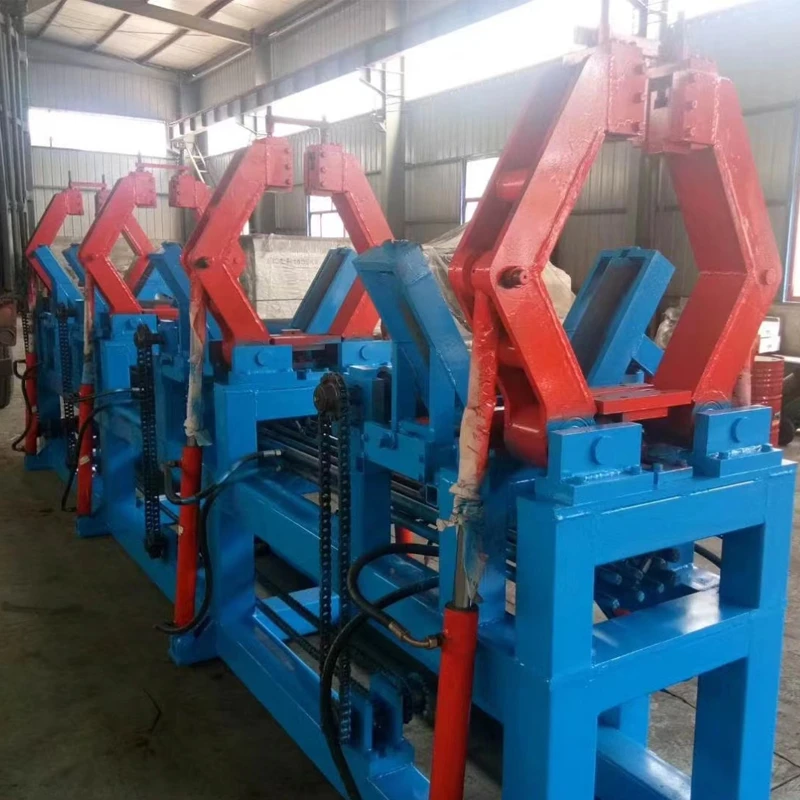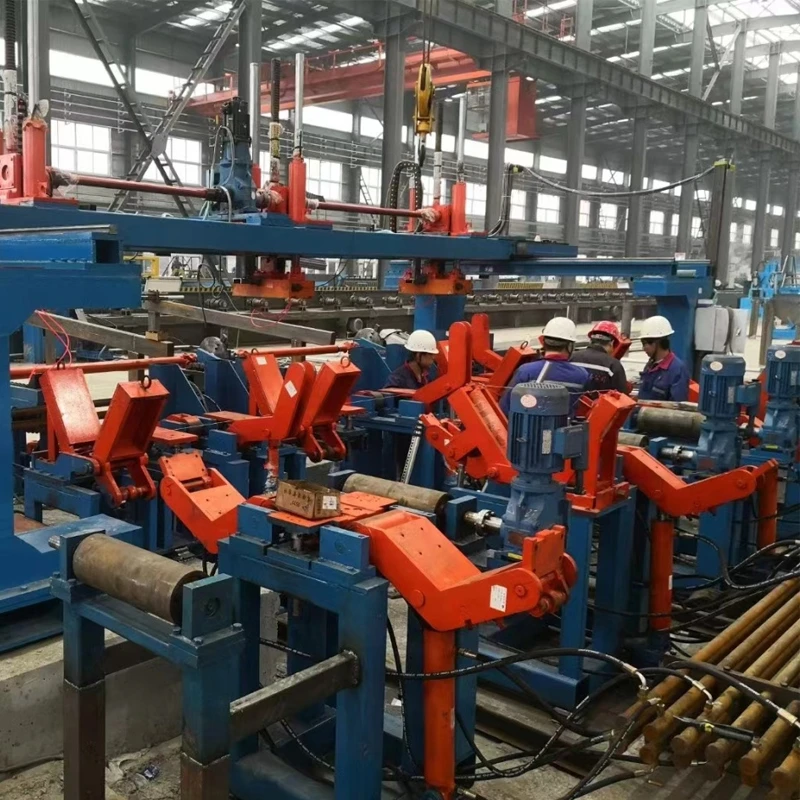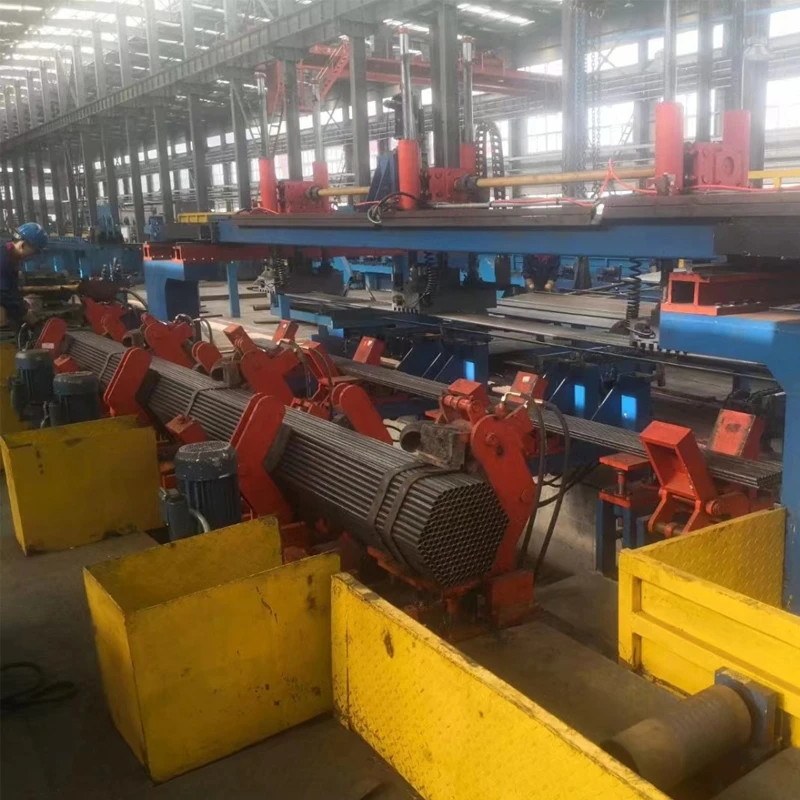Automatic Pipe Belling Machine - Precision & Speed
Understanding the Core of Pipe Production: The Belling Machine
The industrial landscape for pipe manufacturing is constantly evolving, driven by demands for higher efficiency, precision, and material versatility. At the heart of this evolution, particularly for PVC, PE, and PP pipe production, lies the critical technology of the belling machine. These sophisticated systems are indispensable for creating the flared, socketed ends of pipes, enabling secure and leak-proof connections in various piping networks. Beyond mere functionality, modern belling machines integrate advanced automation and control systems, ensuring uniform quality, reduced labor costs, and significantly enhanced production throughput. Industry trends indicate a persistent demand for machines capable of handling larger diameters and thicker walls, while also incorporating smart diagnostics and remote monitoring capabilities to minimize downtime and optimize operational efficiency. This shift towards intelligent manufacturing aligns with the broader Industry 4.0 paradigm, where data-driven insights are leveraged to predict maintenance needs and fine-tune operational parameters, thereby maximizing return on investment for pipe manufacturers. Furthermore, as environmental regulations tighten, the emphasis is also on energy-efficient designs and reduced material waste during the belling process, making advanced belling technology a cornerstone of sustainable industrial practices. This section provides a foundational understanding of the belling machine's pivotal role and its continuous advancement within the contemporary pipe manufacturing sector, underscoring its importance for infrastructure development and industrial applications across the globe.
The demand for robust and reliable pipe systems in sectors like urban water supply, irrigation, telecommunications conduit, and chemical processing continues to fuel innovation in belling technology. Manufacturers are increasingly looking for solutions that offer rapid changeover times between different pipe sizes and materials, along with integrated cooling systems to maintain dimensional stability immediately after the belling process. The adoption of high-precision servo motors and advanced hydraulic systems ensures consistent belling dimensions and reduces the likelihood of pipe deformation, which is crucial for meeting stringent industry standards such as ISO 4427 for PE pipes or ASTM D1785 for PVC pipes. Moreover, the integration of real-time quality control mechanisms, including laser measurement systems, allows for immediate detection and correction of deviations, ensuring that every bell-end meets precise specifications. This level of automation not only boosts productivity but also reduces the reliance on manual inspection, significantly lowering the potential for human error. The synergy of mechanical robustness, electronic precision, and intelligent software forms the backbone of the next-generation belling machines, making them pivotal assets in achieving competitive advantages in the global pipe manufacturing market. Their versatility extends to supporting various pipe types, including those destined for use with purlin machine fabricated structures or specialized applications involving shutter machine components, showcasing their broad applicability within diverse industrial ecosystems.
The Advanced Manufacturing Process of a Belling Machine
The creation of a high-performance belling machine involves a meticulously engineered manufacturing process, integrating state-of-the-art techniques and stringent quality control at every stage to ensure durability, precision, and longevity. The process begins with the selection of premium materials, typically high-grade steel alloys for structural components, known for their exceptional tensile strength and resistance to fatigue. Components critical for belling accuracy, such as mandrels and dies, are often crafted from specialized tool steels or hardened alloys through advanced casting or forging processes. Casting provides the foundation for complex geometries in machine frames, ensuring rigidity and stability under continuous operation, while forging is employed for components requiring superior strength and impact resistance, like connecting rods or clamping mechanisms. Following initial fabrication, critical parts undergo precision CNC machining, achieving micron-level tolerances essential for repeatable belling quality. This ensures that the pipe end uniformly expands without stress concentrations, maintaining the structural integrity of the final product. Surface treatments, including nitriding, chrome plating, or specialized anti-corrosion coatings, are then applied to enhance wear resistance and extend the operational life of components, particularly those exposed to friction or corrosive environments. These treatments are vital for machines operating in diverse environments, from arid construction sites to humid coastal regions.

Post-machining, all components undergo rigorous inspection adhering to international standards such as ISO 9001 for quality management systems and ANSI for dimensional accuracy. Non-destructive testing methods like ultrasonic testing and magnetic particle inspection are routinely employed to detect any internal flaws or surface cracks before assembly. The assembly phase is conducted in a controlled environment, where highly skilled technicians meticulously integrate mechanical, hydraulic, pneumatic, and electrical systems. Each hydraulic circuit is pressure-tested to ensure leak-proof operation, and electrical wiring conforms to CE or UL standards, guaranteeing operational safety and electromagnetic compatibility. Calibration is a critical step, where the machine’s parameters, including heating temperature, belling pressure, and cooling time, are precisely tuned using sophisticated diagnostic tools to achieve optimal performance across the specified range of pipe materials and diameters. The operational lifespan of a well-maintained belling machine can easily exceed 15-20 years, making it a long-term investment. They are widely utilized across various industries, including petrochemical for specialized conduits, metallurgy for conveying processes, and particularly in the critical water supply and drainage sectors where reliable, leak-free pipe connections are paramount. Their ability to consistently produce precise pipe bells contributes significantly to energy efficiency by minimizing pressure drops and preventing fluid loss, while specialized anti-corrosion treatments ensure longevity even when dealing with aggressive media, providing substantial advantages in demanding operational environments.
Technical Parameters and Performance Benchmarks
The performance of a belling machine is defined by a comprehensive set of technical parameters that dictate its capabilities and suitability for specific applications. Understanding these specifications is crucial for prospective buyers to align machine capabilities with their production requirements. Key parameters include the pipe diameter range it can process, typically from DN50mm up to DN630mm or even larger for industrial-scale models, and the compatible wall thickness, which can vary from 2mm to 25mm, accommodating both standard and heavy-duty pipes. The type of belling—R-type (rubber ring seal), U-type (solvent cement), or square-type for conduit applications—is a fundamental selection criterion, as each requires specific tooling and process control. Production speed, measured in bells per minute (BPM), is a direct indicator of throughput, with advanced machines achieving 2-10 BPM depending on pipe dimensions and material. Power consumption is also a vital consideration, influencing operational costs and environmental footprint, with modern machines often featuring energy-efficient hydraulic systems and smart temperature controls. The control system, primarily PLC (Programmable Logic Controller) with an intuitive HMI (Human-Machine Interface), ensures precise process control, diagnostic capabilities, and easy parameter adjustment. The physical dimensions and weight of the machine are important for facility planning, while features like automatic pipe feeding and discharge systems enhance automation and reduce manual handling.

To illustrate the typical specifications, consider the following generalized technical parameters for a high-efficiency belling machine, which are benchmarked against industry standards to ensure optimal performance and reliability. These parameters are often verified through rigorous testing, including durability tests exceeding 10,000 continuous belling cycles and dimensional accuracy tests ensuring deviations of less than ±0.5mm on bell diameters. The table below provides a representative overview of critical specifications. Such detailed technical data, combined with comprehensive performance curves for different materials, offers a transparent basis for evaluating and comparing various belling machine models available in the market. The robust design of these machines often allows them to seamlessly integrate into existing pipe extrusion lines, complementing equipment such as erw pipe machine or those used in the production of corrugated pipes, demonstrating their versatility and adaptability within complex manufacturing ecosystems. This integration capability is key for manufacturers looking to streamline their production processes and achieve higher levels of automation, ultimately leading to greater output and lower per-unit costs, reinforcing their competitive edge in a demanding global market.
| Parameter | Specification Range | Units |
|---|---|---|
| Pipe Diameter Range | 50 - 630 | mm |
| Wall Thickness Range | 2 - 25 | mm |
| Belling Type Compatibility | R-type, U-type, Square | N/A |
| Production Speed (Average) | 2 - 8 | Bells/Minute |
| Heating Method | Infrared / Electric Oven | N/A |
| Cooling System | Air / Water Cooling | N/A |
| Control System | PLC with HMI Touch Screen | N/A |
| Installed Power | 15 - 50 | kW |
| Compressed Air Pressure | 0.6 - 0.8 | MPa |
Strategic Advantages and Customization Solutions
Investing in an advanced belling machine offers multifaceted strategic advantages for pipe manufacturers, extending beyond mere production capacity to encompass operational efficiency, product quality, and market competitiveness. Key technical advantages include superior belling consistency due to precise temperature control and pneumatic or hydraulic pressure regulation, minimizing material stress and ensuring uniform bell geometry. This precision significantly reduces defects and material waste, leading to substantial cost savings. Furthermore, modern belling machines boast rapid tooling changeover capabilities, often facilitated by quick-release mechanisms and automated parameter adjustments, drastically cutting downtime when switching between different pipe sizes or belling types. Energy efficiency is another crucial advantage, with optimized heating elements and smart power management systems reducing electricity consumption by up to 20% compared to older models, directly impacting the operational bottom line. The integrated safety features, compliant with international directives like the Machinery Directive 2006/42/EC, provide a secure working environment, reducing the risk of accidents and ensuring regulatory compliance. These machines are engineered for robust continuous operation, capable of running 24/7 with minimal supervision, making them ideal for high-volume manufacturing environments where consistent output is paramount.

Recognizing that every manufacturing operation has unique requirements, reputable manufacturers offer extensive customization solutions for their belling machine lines. This can range from adapting heating oven lengths for specific pipe materials and wall thicknesses to designing bespoke mandrels for non-standard bell geometries or specialized fittings. For instance, clients requiring machines for large-diameter, thick-walled pipes often need reinforced frames and higher tonnage hydraulic cylinders, while those focusing on intricate applications may demand multi-stage belling processes. Integration with existing extrusion lines, automatic stacking systems, or even robotic handling solutions is also a common customization request, ensuring seamless workflow and maximizing automation. Manufacturers often conduct in-depth consultations and site assessments to provide tailored solutions that optimize factory layout and production flow. The ability to customize extends to control software, allowing for integration with plant-wide SCADA systems, enabling remote monitoring, data logging, and predictive maintenance capabilities. This bespoke approach ensures that the belling machine not only meets immediate production needs but also offers scalability and adaptability for future growth, cementing its role as a strategic asset in a competitive market landscape, capable of handling diverse requirements from specialized purlin machine fabrication to high-volume standard pipe production.
Real-World Applications and Success Stories
The versatility and reliability of modern belling machine technology are best exemplified through their diverse applications across critical industries. In the urban infrastructure sector, these machines are indispensable for producing PVC and PE pipes used in potable water distribution, sewerage systems, and drainage networks. A notable case involved a municipal project in Southeast Asia that required millions of meters of large-diameter PE pipes (up to DN630mm) with specific R-type bells for rubber ring seals, demanding consistent quality under high-volume production. By deploying a fully automated belling line capable of 6 bells/minute, the manufacturer was able to meet the stringent project deadlines and quality standards, significantly reducing installation time on-site due to perfectly matched bell-and-spigot joints. This project showcased the machine's ability to maintain tight dimensional tolerances and achieve high throughput, crucial for large-scale public works. Another significant application is in the agricultural sector, where irrigation systems rely heavily on robust, easily connectable PVC pipes. Here, the machines often need to handle pipes with thinner walls but still produce strong, reliable solvent-cement joints (U-type bells), highlighting the adaptability of the belling process to varying material properties and functional requirements.

Beyond traditional piping, belling machine units are increasingly integrated into specialized manufacturing processes. For instance, in the telecommunications industry, they are used to produce conduits for fiber optic cables, often requiring square-type bells or unique profiles to protect sensitive cabling. One telecommunications giant recently partnered with a machine manufacturer to develop a custom belling solution for HDPE conduits, where extreme precision was required to prevent cable snags during installation. The tailored machine, featuring advanced heating zones and a specialized clamping system, achieved a defect rate of less than 0.01%, far exceeding industry averages. Similarly, in the building and construction industry, pipes for heating, ventilation, and air conditioning (HVAC) systems, sometimes incorporating elements from shutter machine technology for specific ventilation needs, also benefit from precise belling. These application cases underscore the critical role of modern belling technology in enabling complex infrastructure projects and specialized industrial production, demonstrating proven track records of enhancing efficiency, ensuring quality, and facilitating the rapid deployment of essential piping solutions worldwide.
Ensuring Trust: FAQ, Delivery, and Support
Frequently Asked Questions (FAQ)
-
Q1: What is the typical lead time for a custom belling machine?
A1: For standard models, the delivery cycle is typically 4-6 weeks from order confirmation. For highly customized solutions, lead times can range from 8 to 14 weeks, depending on the complexity of design, material sourcing, and specialized component manufacturing. We provide a detailed project timeline upon order confirmation.
-
Q2: What kind of warranty and after-sales support do you offer?
A2: We provide a comprehensive 2-year warranty covering manufacturing defects and major component failures. Our after-sales support includes 24/7 technical assistance via phone and email, remote diagnostic capabilities, and on-site technician dispatch for critical issues. We also offer routine maintenance contracts and spare parts supply to ensure minimal operational disruption.
-
Q3: Can your belling machine integrate with existing pipe extrusion lines from other manufacturers?
A3: Yes, our belling machines are designed with high compatibility in mind. They feature flexible interfaces (e.g., PLC communication protocols like Modbus, Ethernet/IP) that allow for seamless integration with a wide range of upstream extrusion lines, including those from various manufacturers. We offer full technical support during the integration process to ensure smooth operation and optimal synchronization.
-
Q4: What material types can your belling machine process?
A4: Our machines are primarily designed to process a broad spectrum of thermoplastic pipes, including PVC (Polyvinyl Chloride), PE (Polyethylene), PP (Polypropylene), PPR (Polypropylene Random Copolymer), and HDPE (High-Density Polyethylene). Specific models may offer enhanced capabilities for particular materials, which can be discussed during the consultation phase to match your exact production needs.
Our commitment to customer satisfaction extends beyond the sale of a belling machine. We understand that reliable delivery and comprehensive post-sales support are paramount for uninterrupted production and long-term success. Our dedicated logistics team manages the entire shipping process, ensuring timely and secure delivery to your facility, whether domestic or international. Upon arrival, our experienced engineers are available for installation, commissioning, and comprehensive operator training, empowering your team to maximize the machine's potential. Furthermore, our readily available inventory of genuine spare parts and consumables minimizes potential downtime, providing peace of mind. We pride ourselves on building enduring partnerships with our clients, offering continuous technical consultation and software updates to ensure your investment remains at the forefront of pipe manufacturing technology. This holistic approach to service, from initial inquiry to decades of operation, solidifies our reputation as a trusted partner in the industry, distinguishing us from competitors and reinforcing the value proposition of our advanced belling solutions.
References
- ISO 4427-2:2019 - Plastics piping systems for water supply, and for drainage and sewerage under pressure — Polyethylene (PE) — Part 2: Pipes.
- ASTM D1785 - Standard Specification for Poly(Vinyl Chloride) (PVC) Plastic Pipe, Schedules 40, 80, and 120.
- Machinery Directive 2006/42/EC - European Parliament and Council Directive on machinery.
- ANSI/AWWA C900-16 - Polyvinyl Chloride (PVC) Pressure Pipe and Fabricated Fittings, 4 In. Through 60 In. (100 mm Through 1,500 mm).
- Hydraulics and Pneumatics - Principles and Practice, Andrew Parr, Butterworth-Heinemann.
-
Top Hose Crimper Sales: Hydraulic, Manual & Electric OptionsNewsAug.28,2025
-
Precision Belling Machine | Automated Pipe End FormingNewsAug.27,2025
-
High-Efficiency Automatic Belling Machine for PipesNewsAug.26,2025
-
High-Quality Line Pipe Steel for Oil & Gas PipelinesNewsAug.21,2025
-
Advanced PVC Belling Machine for Efficient Pipe ProductionNewsAug.19,2025
-
High-Frequency Straight Seam Welded Pipe Production Line-BzZhou Xinghua Machinery Equipment Manufacturing Co., Ltd.|Steel Pipe Manufacturing, Precision EngineeringNewsAug.18,2025


